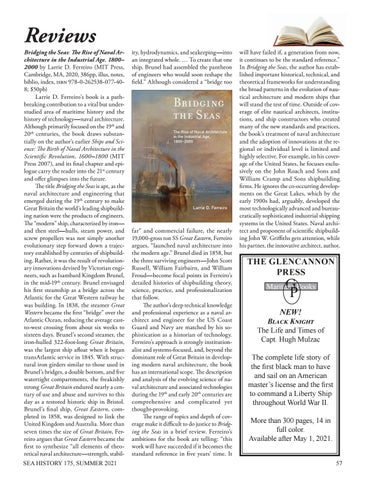Reviews
Bridging the Seas: The Rise of Naval Architecture in the Industrial Age, 1800– 2000 by Larrie D. Ferreiro (MIT Press, Cambridge, MA, 2020, 386pp, illus, notes, biblio, index, isbn 978-0-262538-077-408; $50pb) Larrie D. Ferreiro’s book is a pathbreaking contribution to a vital but understudied area of maritime history and the history of technology—naval architecture. Although primarily focused on the 19th and 20th centuries, the book draws substantially on the author’s earlier Ships and Science: The Birth of Naval Architecture in the Scientific Revolution, 1600–1800 (MIT Press 2007), and its final chapter and epilogue carry the reader into the 21st century and offer glimpses into the future. The title Bridging the Seas is apt, as the naval architecture and engineering that emerged during the 19th century to make Great Britain the world’s leading shipbuilding nation were the products of engineers. The “modern” ship, characterized by iron— and then steel—hulls, steam power, and screw propellers was not simply another evolutionary step forward down a trajectory established by centuries of shipbuilding. Rather, it was the result of revolutionary innovations devised by Victorian engineers, such as Isambard Kingdom Brunel, in the mid-19th century. Brunel envisaged his first steamship as a bridge across the Atlantic for the Great Western railway he was building. In 1838, the steamer Great Western became the first “bridge” over the Atlantic Ocean, reducing the average eastto-west crossing from about six weeks to sixteen days. Brunel’s second steamer, the iron-hulled 322-foot-long Great Britain, was the largest ship afloat when it began transAtlantic service in 1845. With structural iron girders similar to those used in Brunel’s bridges, a double bottom, and five watertight compartments, the freakishly strong Great Britain endured nearly a century of use and abuse and survives to this day as a restored historic ship in Bristol. Brunel’s final ship, Great Eastern, completed in 1858, was designed to link the United Kingdom and Australia. More than seven times the size of Great Britain, Ferreiro argues that Great Eastern became the first to synthesize “all elements of theoretical naval architecture—strength, stabil-
ity, hydrodynamics, and seakeeping—into an integrated whole. … To create that one ship, Brunel had assembled the pantheon of engineers who would soon reshape the field.” Although considered a “bridge too
far” and commercial failure, the nearly 19,000-gross ton SS Great Eastern, Ferreiro argues, “launched naval architecture into the modern age.” Brunel died in 1858, but the three surviving engineers—John Scott Russell, William Fairbairn, and William Froud—become focal points in Ferreiro’s detailed histories of shipbuilding theory, science, practice, and professionalization that follow. The author’s deep technical knowledge and professional experience as a naval architect and engineer for the US Coast Guard and Navy are matched by his sophistication as a historian of technology. Ferreiro’s approach is strongly institutionalist and systems-focused, and, beyond the dominant role of Great Britain in developing modern naval architecture, the book has an international scope. The description and analysis of the evolving science of naval architecture and associated technologies during the 19th and early 20th centuries are comprehensive and complicated yet thought-provoking. The range of topics and depth of coverage make it difficult to do justice to Bridging the Seas in a brief review. Ferreiro’s ambitions for the book are telling: “this work will have succeeded if it becomes the standard reference in five years’ time. It
will have failed if, a generation from now, it continues to be the standard reference.” In Bridging the Seas, the author has established important historical, technical, and theoretical frameworks for understanding the broad patterns in the evolution of nautical architecture and modern ships that will stand the test of time. Outside of coverage of elite nautical architects, institutions, and ship constructors who created many of the new standards and practices, the book’s treatment of naval architecture and the adoption of innovations at the regional or individual level is limited and highly selective. For example, in his coverage of the United States, he focuses exclusively on the John Roach and Sons and William Cramp and Sons shipbuilding firms. He ignores the co-occurring developments on the Great Lakes, which by the early 1900s had, arguably, developed the most technologically advanced and bureaucratically sophisticated industrial shipping The Glencannon Press systems in the United States. archi4 col. inches (2.25 x 4.5Naval inches) tect and proponent of scientific shipbuildPrefer right hand page, bottom right. ing John W. Griffiths gets attention, while his partner, the innovative architect, author,
THE GLENCANNON PRESS
G P
Maritime Books
NEW!
Black Knight The Life and Times of Capt. Hugh Mulzac The complete life story of the first black man to have and sail on an American master’s license and the first to command a Liberty Ship throughout World War II. More than 300 pages, 14 in full color. Available after May 1, 2021.
SEA HISTORY 175, SUMMER 2021 57
